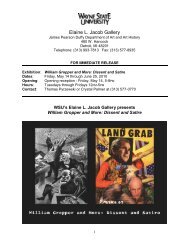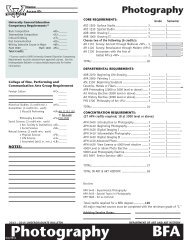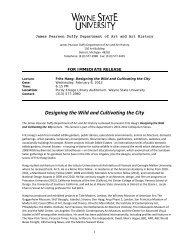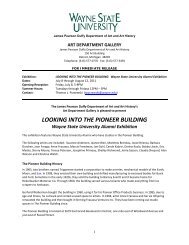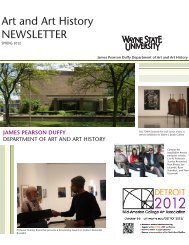linked - Department of Art and Art History - Wayne State University
linked - Department of Art and Art History - Wayne State University
linked - Department of Art and Art History - Wayne State University
You also want an ePaper? Increase the reach of your titles
YUMPU automatically turns print PDFs into web optimized ePapers that Google loves.
epresentations in current art practice. As implements, design components <strong>and</strong> conveyers <strong>of</strong> fantasy<br />
<strong>and</strong> erotic appeal, they serve not only as subject matter, but also as instruments <strong>of</strong> creative<br />
production. From plaster cast to erotic fetish, appendages have long played a role in artists’ vision <strong>and</strong><br />
viewers’ perception. When removed (physically or contextually) from the body, they constitute<br />
dynamic components in the theater <strong>of</strong> human complexity. Exp<strong>and</strong>ing to the non-human realm, a fin,<br />
a fang, a claw or tentacle immediately calls up frightening fantasy.<br />
By way <strong>of</strong> example, consider images <strong>of</strong> feet. One has only to view the tortured beauty <strong>of</strong> Géricault’s<br />
“Study <strong>of</strong> Feet <strong>and</strong> H<strong>and</strong>s,” the religious associations <strong>of</strong> “Christ Washing the Feet <strong>of</strong> the Apostles”<br />
(Durer, Tintoretto), or the pastoral bronze, “Boy with Thorn,” to recognize the poignancy <strong>of</strong> feet as<br />
source imagery. The “foot” is delivered as design element in furniture or vessels, both decorative <strong>and</strong><br />
for structural support. A broader conjecture <strong>of</strong> foot is revealed as emblem <strong>of</strong> freedom as the constraint<br />
<strong>of</strong> movement is a primary obstacle to liberation – think “Freedom Walk.”<br />
What social constructs are identified through the use <strong>of</strong> images <strong>of</strong> appendages How are roles <strong>of</strong> class<br />
<strong>and</strong> gender played out through design or decoration In which ways do shoes <strong>and</strong> other coverings<br />
emerge as signs <strong>of</strong> identity How do footprints or other markers connote memory How do<br />
innovations in prosthetic devices <strong>and</strong> artificial limbs alter our sense <strong>of</strong> the real <strong>and</strong> the (im)possible<br />
“The Prosthetic Aesthetic: An <strong>Art</strong> <strong>of</strong> Anxious Extensions”<br />
Tiffany Funk, <strong>University</strong> <strong>of</strong> Illinois at Chicago<br />
“From Playground to Fetish: The Identity <strong>of</strong> (the) Mary Jane”<br />
Georgina Ruff, <strong>University</strong> <strong>of</strong> Illinois at Chicago<br />
“The Docile Body; the Appearance <strong>of</strong> Absence <strong>of</strong> Authority”<br />
Katherine Sullivan, Hope College<br />
Post-Photographic Forms, Mutations <strong>and</strong> Digital Hybrid<br />
Thursday, October 4, 9:45AM – 11:45 AM<br />
Founders A, Level Three, Westin Book Cadillac Hotel<br />
Chair: Min Kim Park, Purdue <strong>University</strong><br />
We are in a particular moment in photography’s history where many contemporary photography<br />
works reference a diversity <strong>of</strong> genres <strong>and</strong> involve a broad range <strong>of</strong> image-making processes, which I<br />
have also explored in my artistic practice. Examining my work in relationships to other contemporary<br />
artists has allowed me to reflect on current trends in photography <strong>and</strong> its varied mutations. For<br />
example, American artist Sean Snyder downloads amateur snapshots from the Internet, taken by<br />
American soldiers stationed in the current conflict in Iraq, <strong>and</strong> present them systematically in a grid<br />
format. Most <strong>of</strong> the images depict stereotypical scenes: exotic desert sunsets, smiling children<br />
receiving sweets from US troops, <strong>and</strong> unveiled caches <strong>of</strong> rebel weapons. They encourage comparisons<br />
<strong>and</strong> pose the question if the photography is betraying the ideology <strong>of</strong> the soldier-photographer who<br />
took them. Another example is Israel artist Elad Lassry <strong>and</strong> American artist Am<strong>and</strong>a Ross Ho; their<br />
artistic intent is to look at photography simply as a picture devoid <strong>of</strong> a traditional view <strong>of</strong>




